
Get your FREE 30-day trial.
Please complete all fields.
Agents need contextual information to service customers effectively and quickly. Information like contact and account details, entitlements and service contracts and case history must be readily available. Contextual information is not limited to salesforce.com records though. Billing systems, order entry and various other external systems fall under this umbrella. In addition, the knowledge to support the customer should not require a swivel chair. An integrated view of such information empowers the agent, leading to a better customer experience.
At the same time, in most high volume call center environments, agents often are in the process of wrapping up an existing customer interaction when the next call or chat comes in. Keeping the context of a customer interaction alive for the agent to return to is another positive impact on the resolution time.
At the same time, some thought must be given to prevent overloading the agent with information. Interactions must be compartmentalized, and contextual data must be unintrusive. A simple, intuitive user interface will make the agent's day go faster. The learning curve is also easier now.
With all of the above in mind we introduced the Service Cloud Console with the Winter '11 release. This is a game changing user interface, optimized for -
The Service Cloud Console screenshot below shows how this UI paradigm is differs compared to the regular Salesforce application.
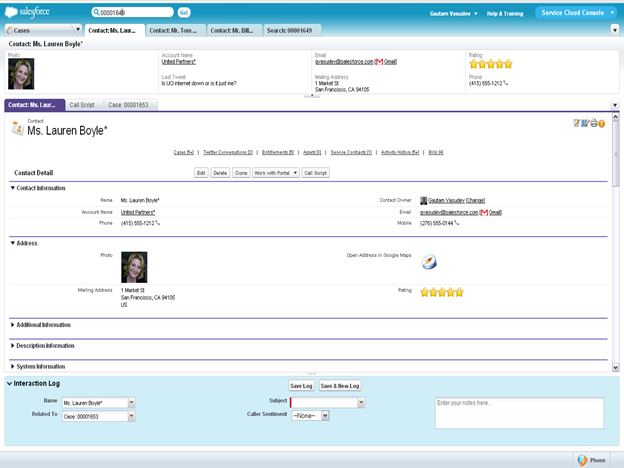
The Service Cloud Console
The primary goal of this interface is to provide agents with the right context at the right time. This is done via -
Each of these is described in the following sections.
The Service Cloud Console uses a new 2 level tabbed UI paradigm. The first tab level, referred to as the primary tab, is the primary interaction record. For example, consider an incoming call from contact Lauren Boyle. The contact record for Ms. Boyle can be set up to be a primary tab. Now the contact opens as a new tab within the Service Cloud Console as shown in the image below.
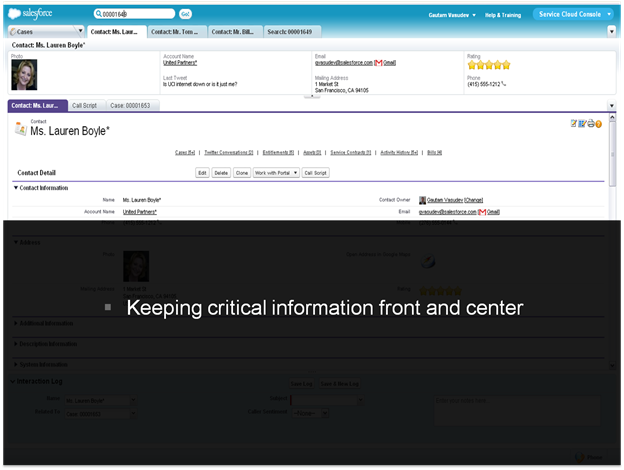
You will notice that case 00001653 has opened as a subtab of the primary tab. This allows the agent to view case information in 1 click without losing the contact details, which are still maintained in the first subtab.
In addition, there are no entity level tabs in the Service Cloud Console, like Accounts, Contacts and Cases. Instead, each primary tab record receives its own tab. To view the various entities like in the regular app, you would click the navigator tab, as shown in the image below.
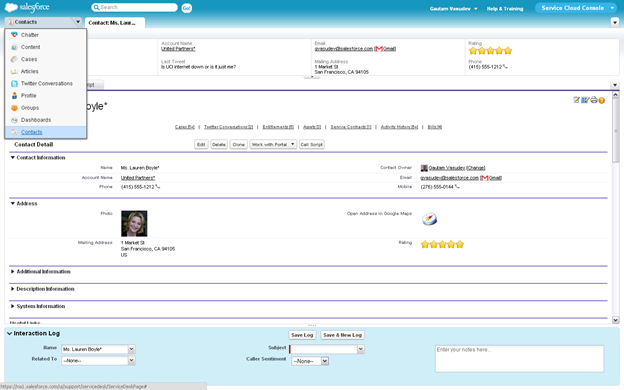
The Navigator Tab
Clicking on any entity in the navigator tab brings you to the list view for that entity.
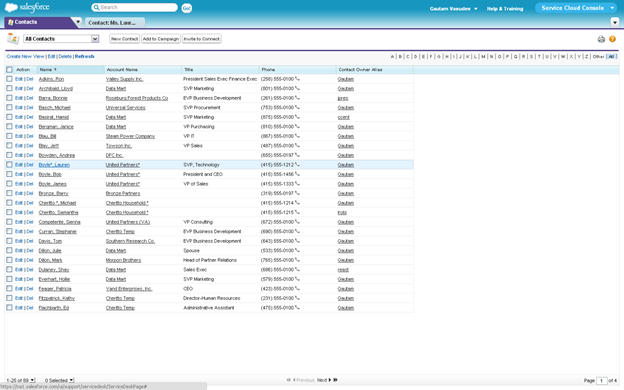
List Views in the Service Cloud Console
Note that the interaction with Ms. Boyle is still available. We can return to it any time. When a new call comes in from another contact, a new primary tab/workspace will open up. The same is true for search. Each search query opens its own primary tab.
Every customer interaction is represented as its own workspace. A workspace includes the one primary and one or many secondary tabs associated with an interaction. In addition, they include an interaction log (more on this below). In our example, the agent received a call from Lauren Boyle, which opened up a Lauren Boyle contact workspace.
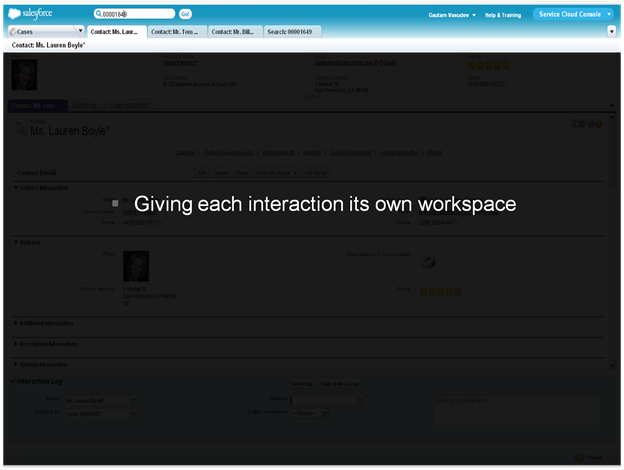
The agent can now multitask between more than one interaction, returning to each as needed. It also makes wrap up much easier since all the context is organized and retained within the workspace.
If a primary tab is associated with a standard object, a "Highlights Panel" will appear in it. This panel can be customized to display the most relevant fields for the primary tab entity record. In our example, we have set the highlights Panel to display Lauren Boyle's email, account and phone number amongst other things.

This allows the system to push and highlight the most relevant information to the agent effectively.
Each workspace comes with an interaction log. This allows agents to record notes related to the interaction. The notes are saved as tasks on the primary tab entity record.
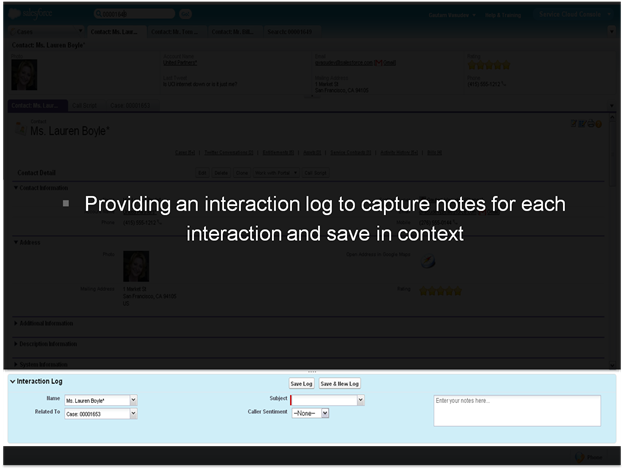
The interaction log can be customized to show any visible field on the task object, and the layout of the fields can be customized as well. The "Related To" and "Name" fields are auto populated, which means less work for the agent.
In the Service Cloud Console the CTI softphone is housed as a widget in a footer.
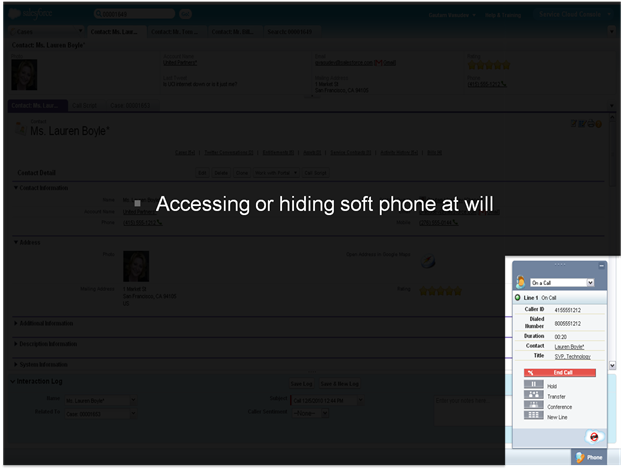
This allows us to save space and provider a cleaner interface for the agent. One click on the "Phone" displays the softphone. An additional click hides it. An incoming call also displays the softphone. If your organization does not have CTI set up, you will not see the widget or footer.
All of the features described above translate to enhanced productivity and an improved user experience for agents. The Service Cloud Console allows agents to –
Before I conclude this blog, I want to point out another highlight of the Service Cloud Console. Improving the agent's experience and productivity has been the driver for our efforts. However, the Service Cloud Console also supports the ability for admins to customize and add to this themselves. The customization support includes –
While we are proud of the work done for this feature, we are focused on its continued improvement. Look forward to more functionality and enhancements in the near future. We are always eager to receive feedback and answer questions. Feel free to post them or contact me or Michael Ramsey. Stay tuned for additional blog entries about the Service Cloud Console and other Service Cloud features.